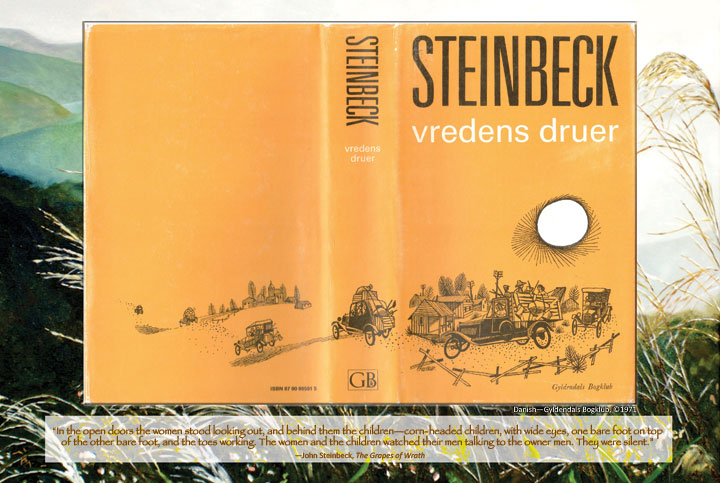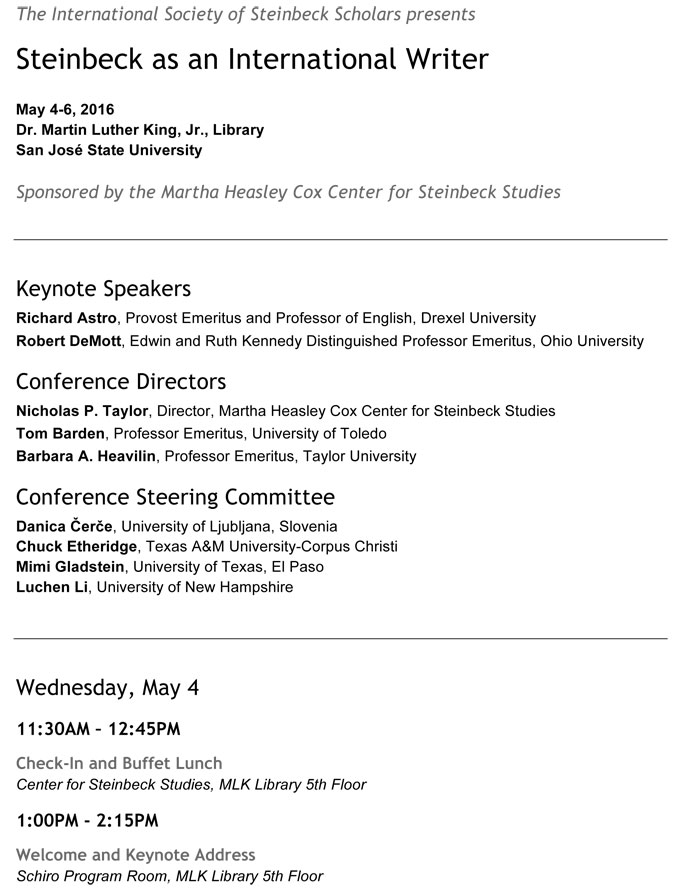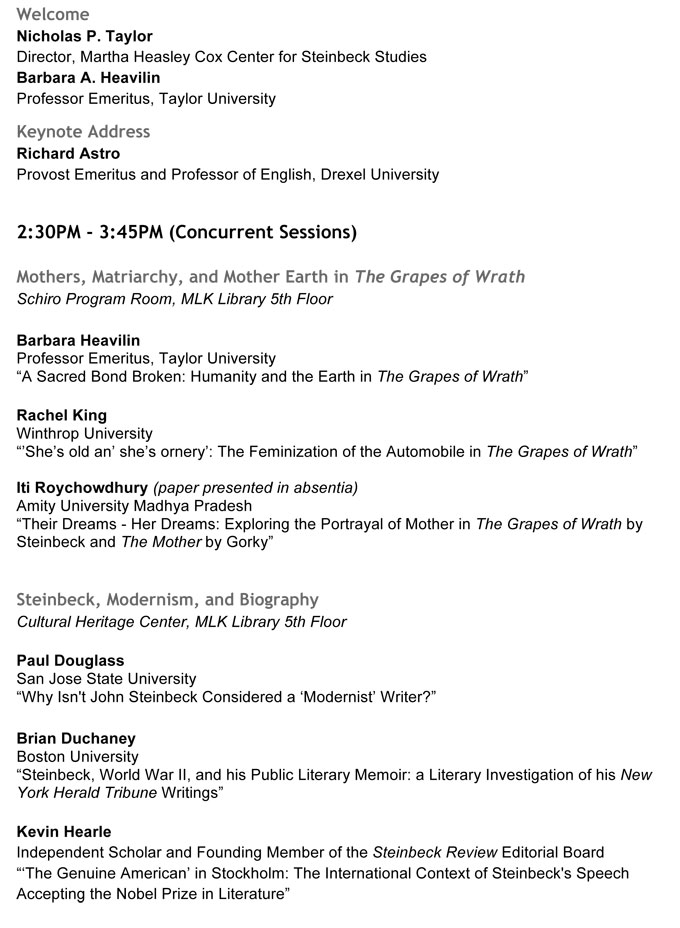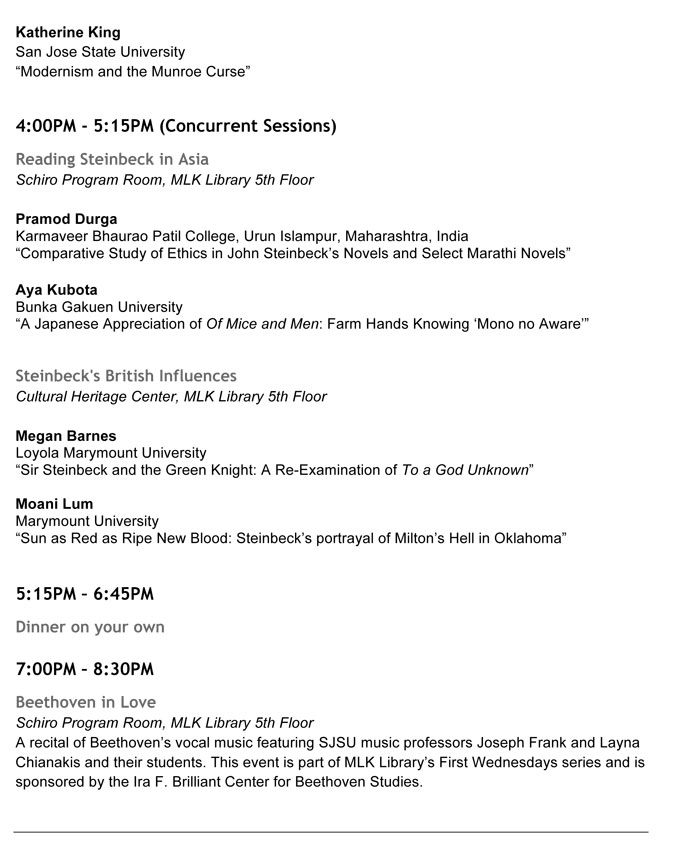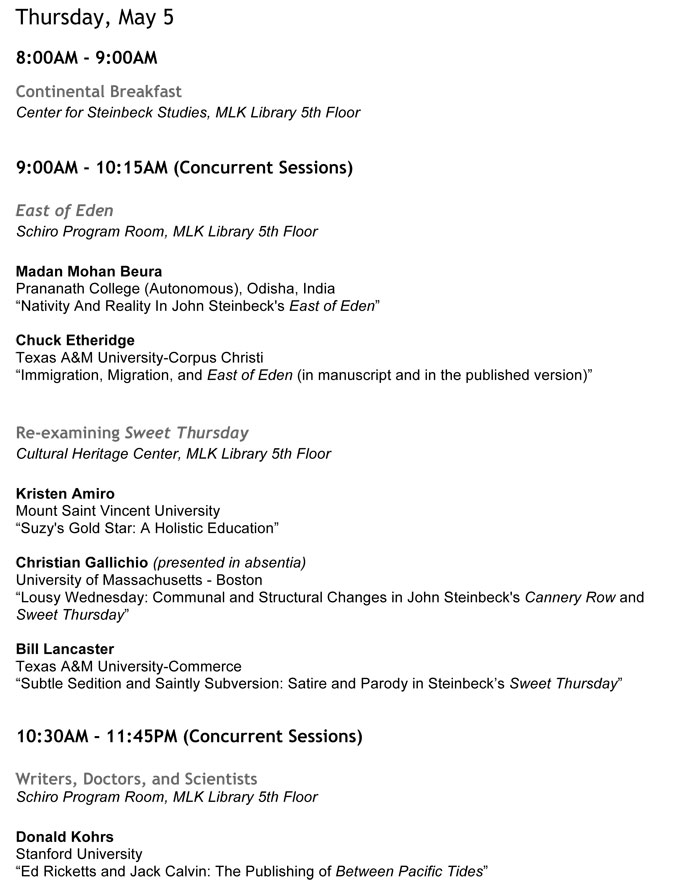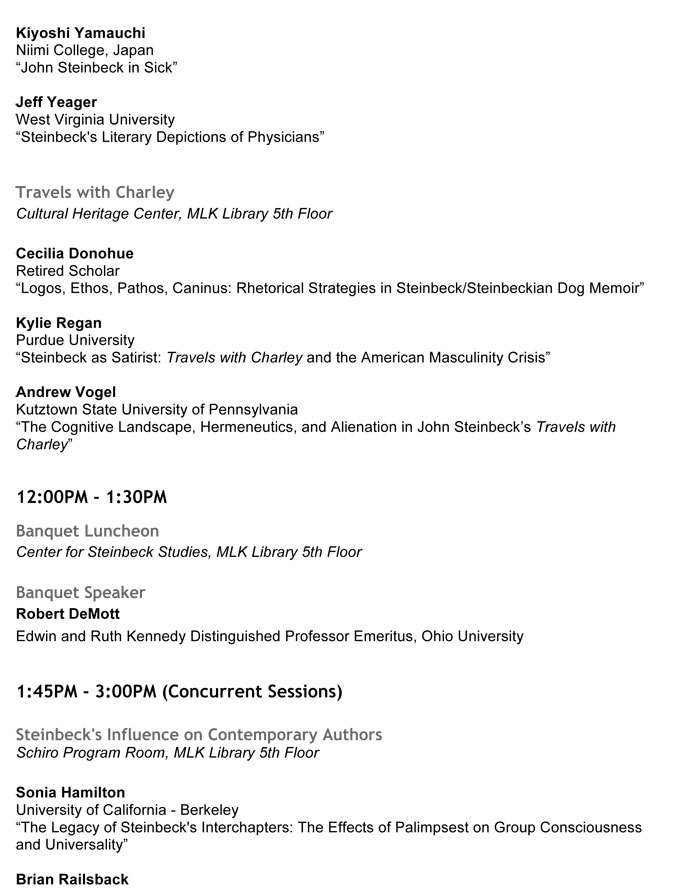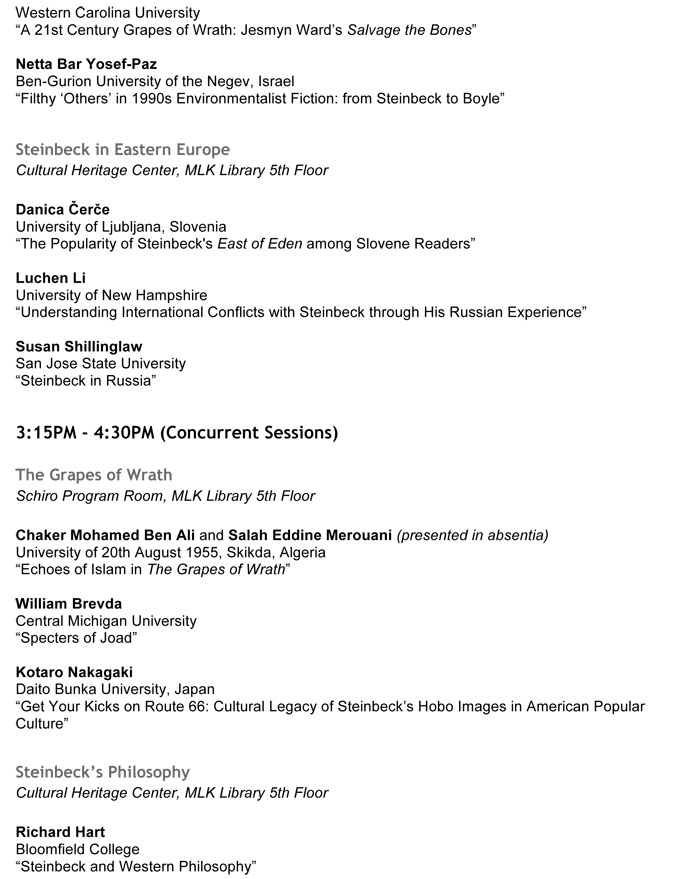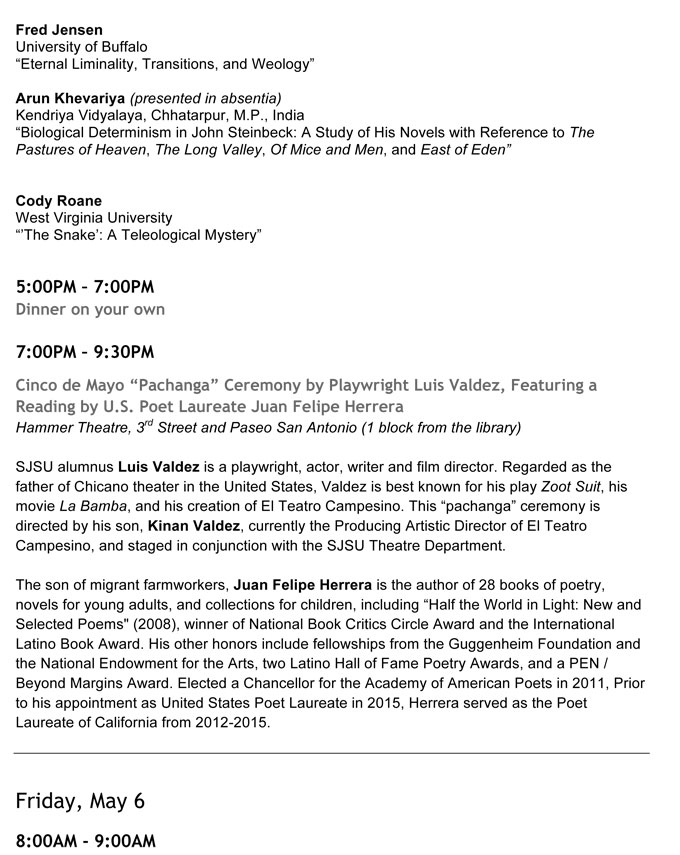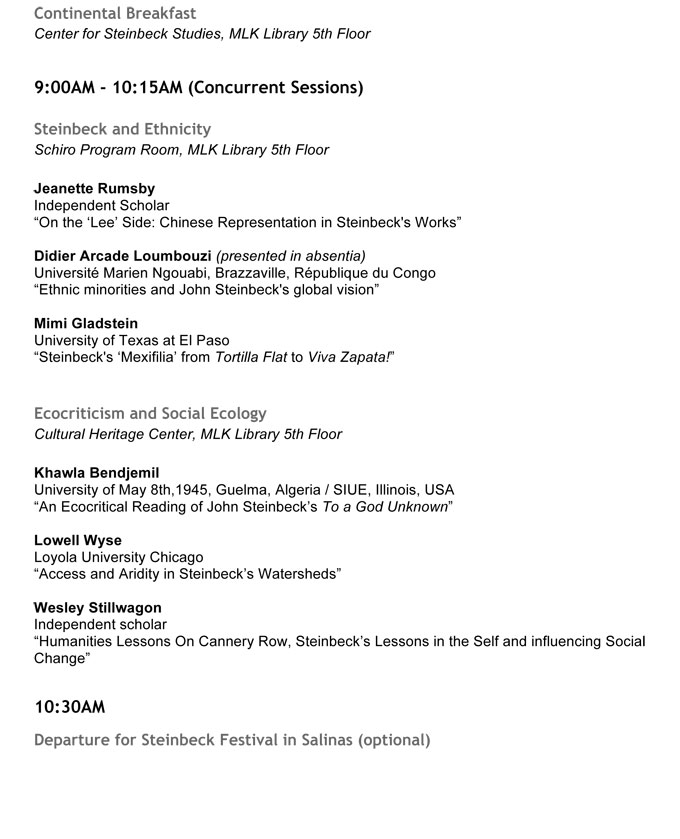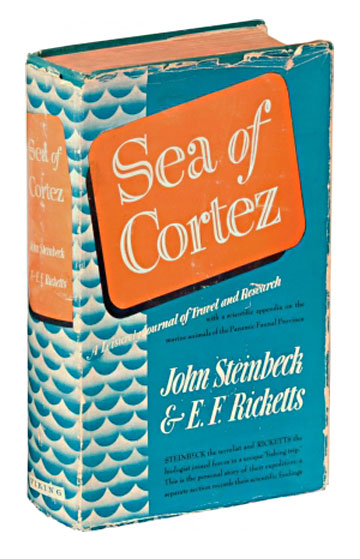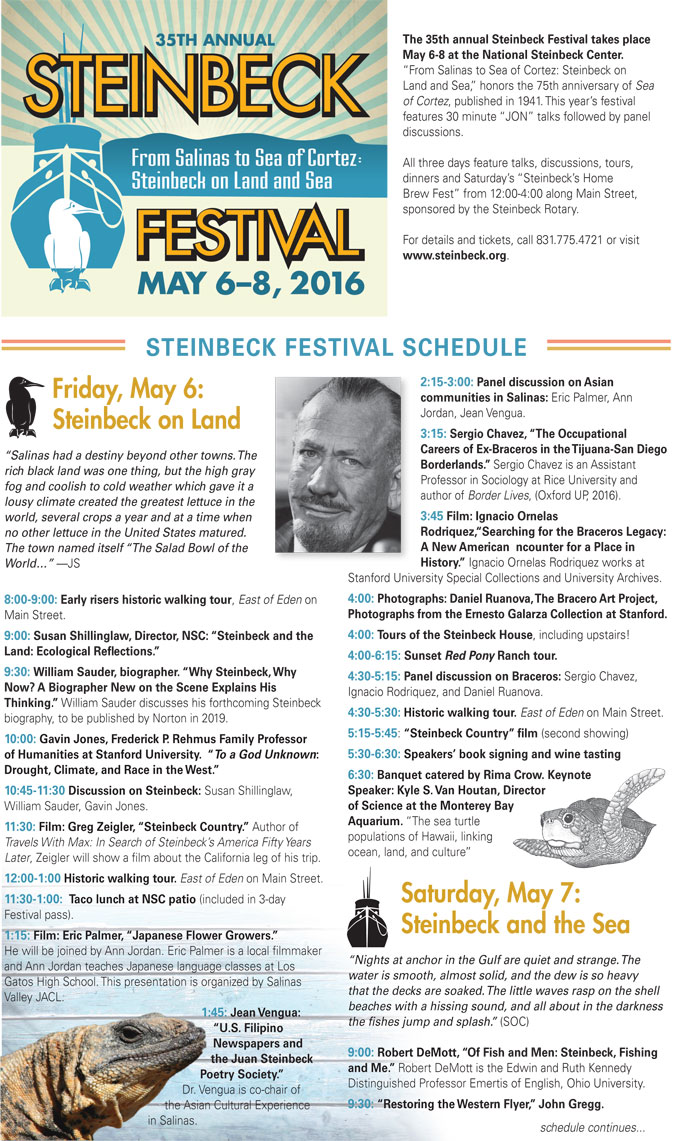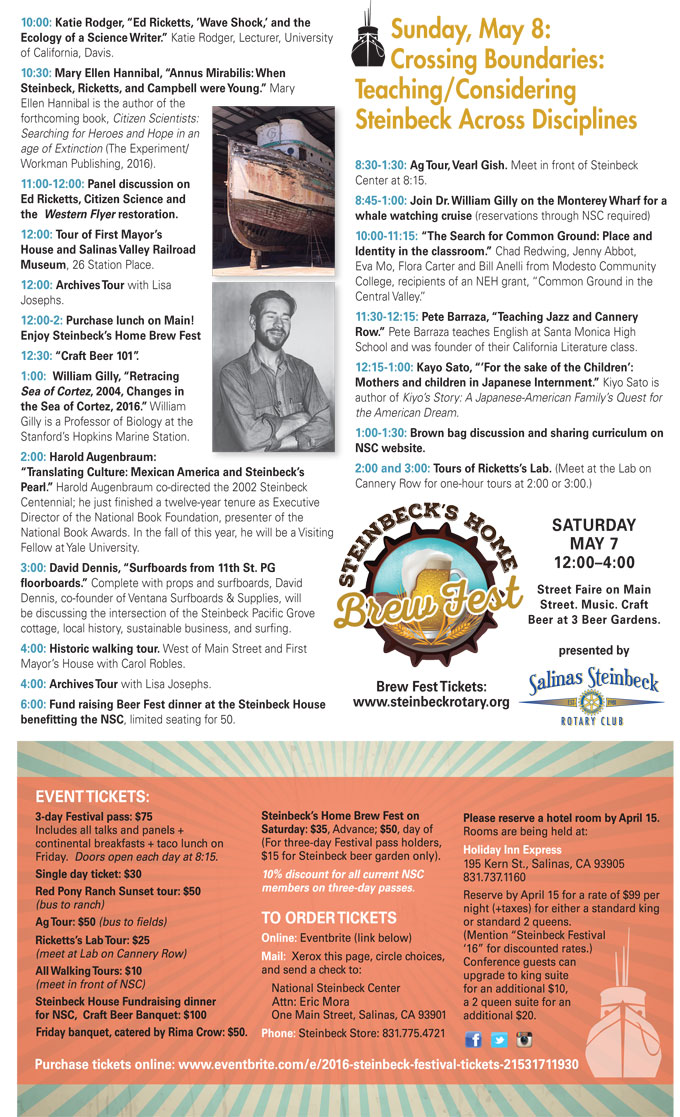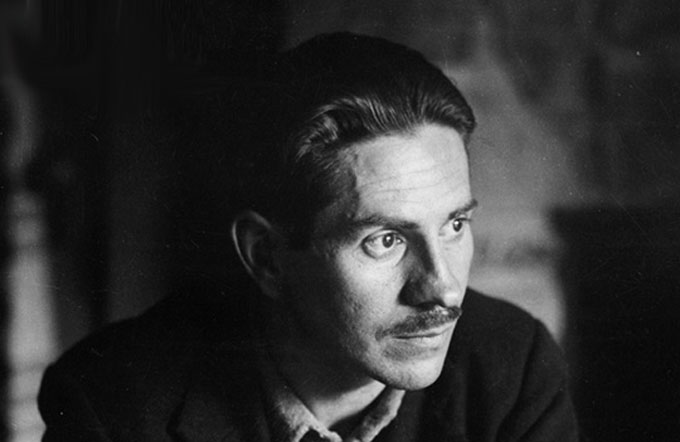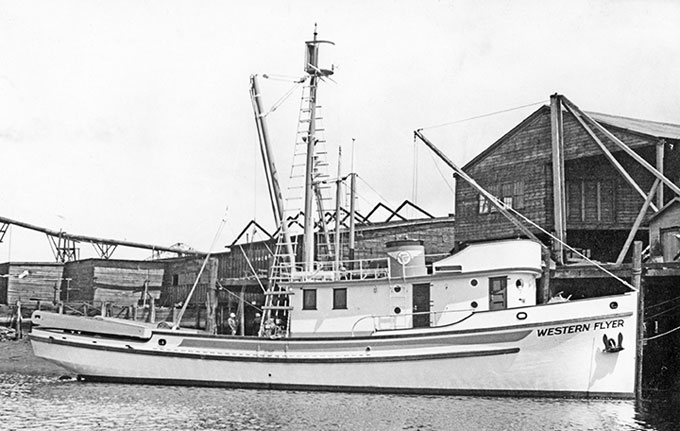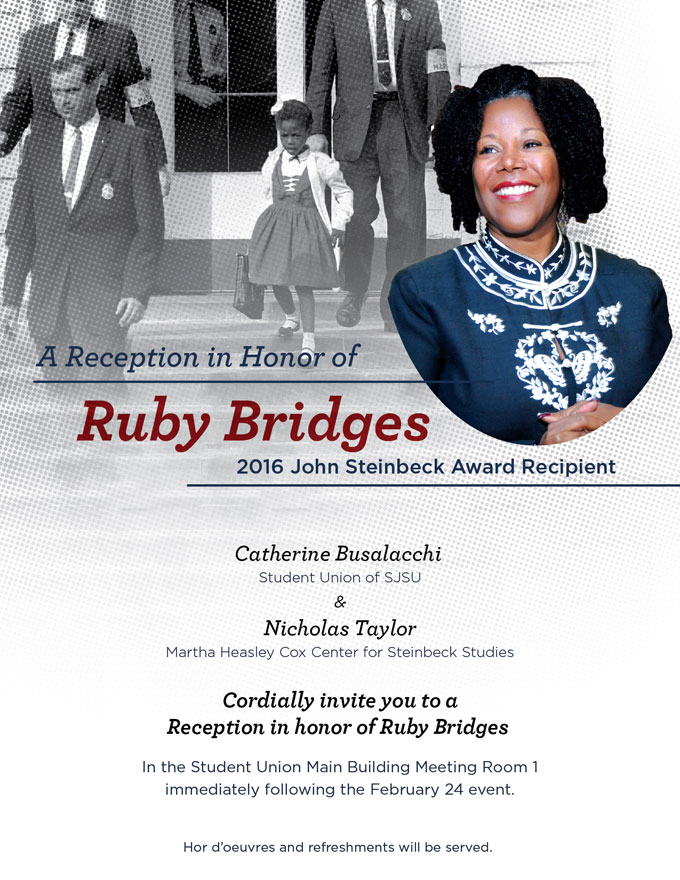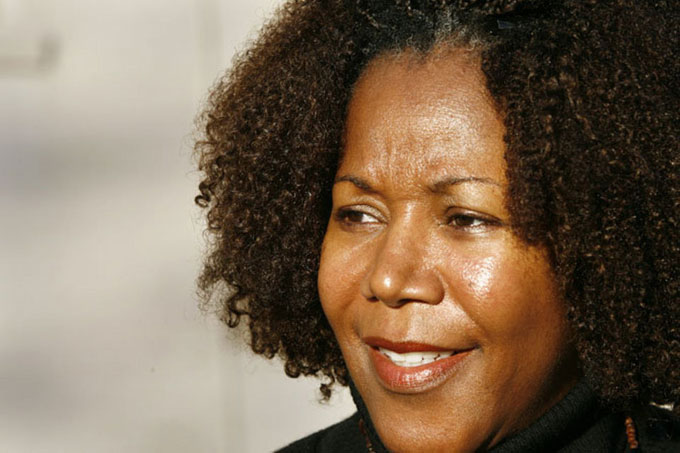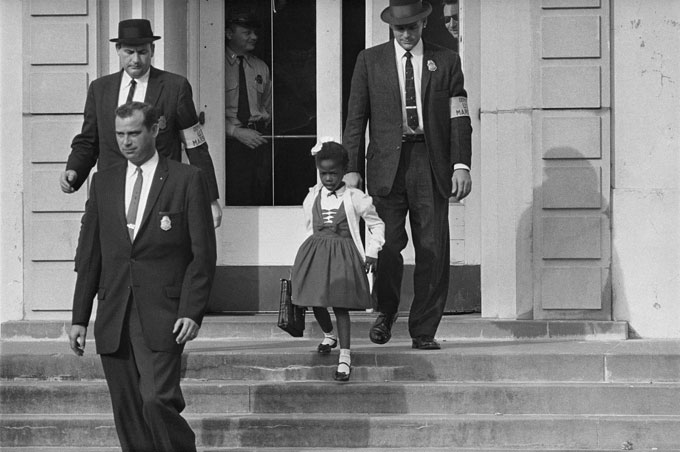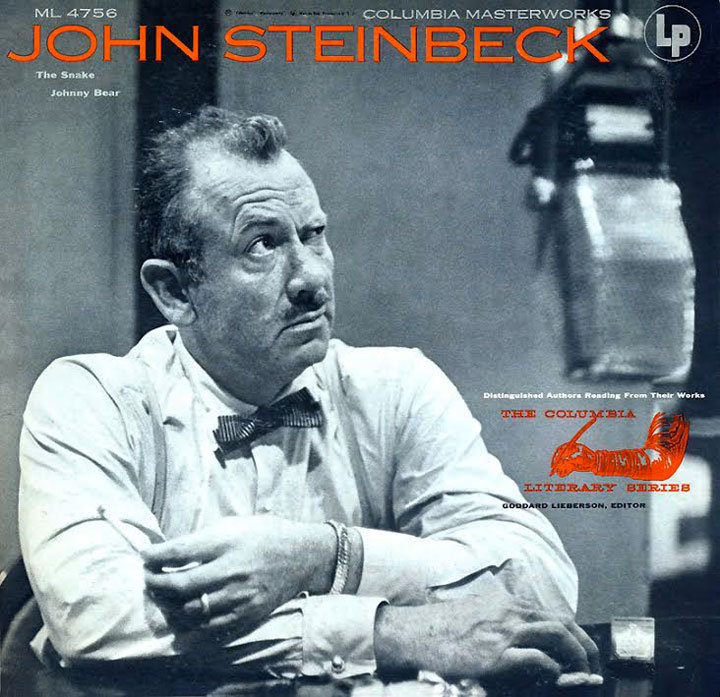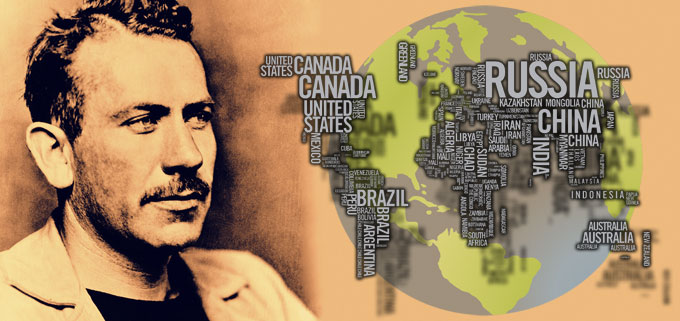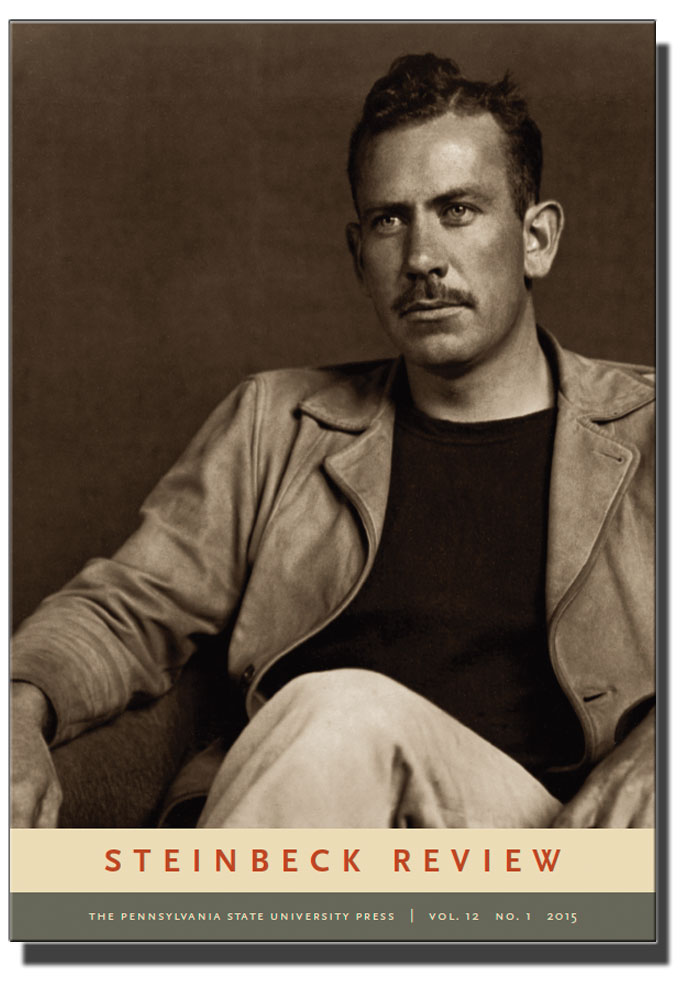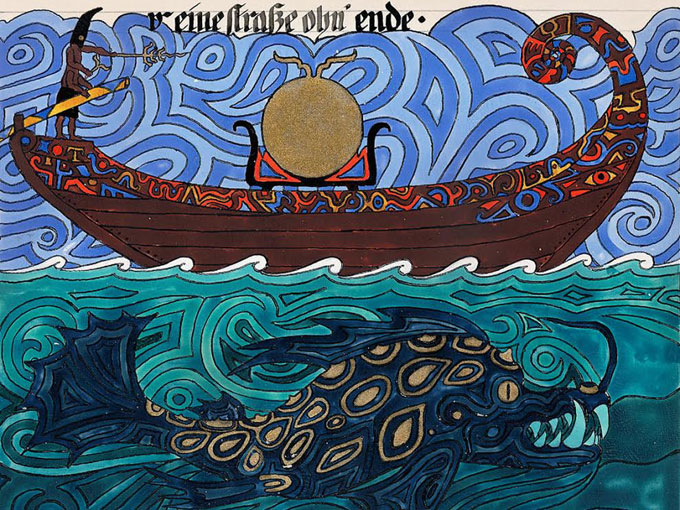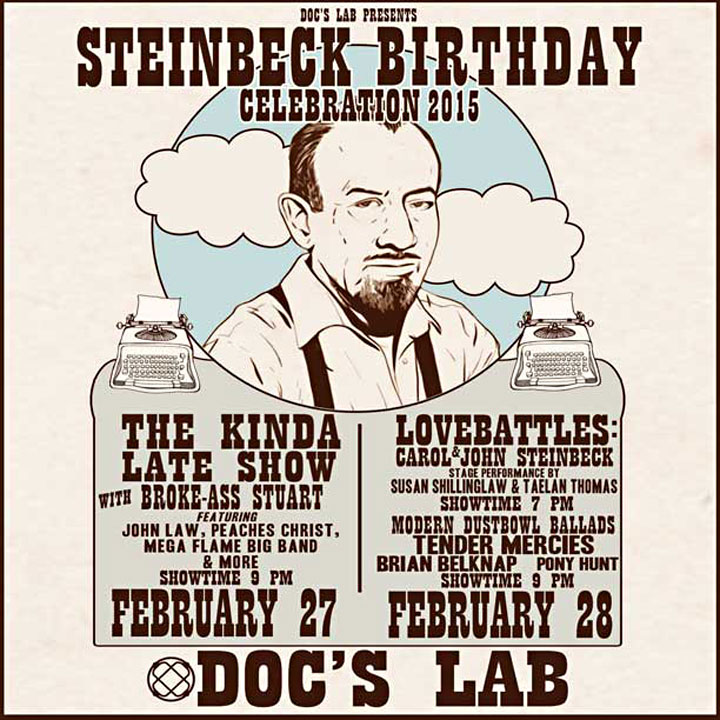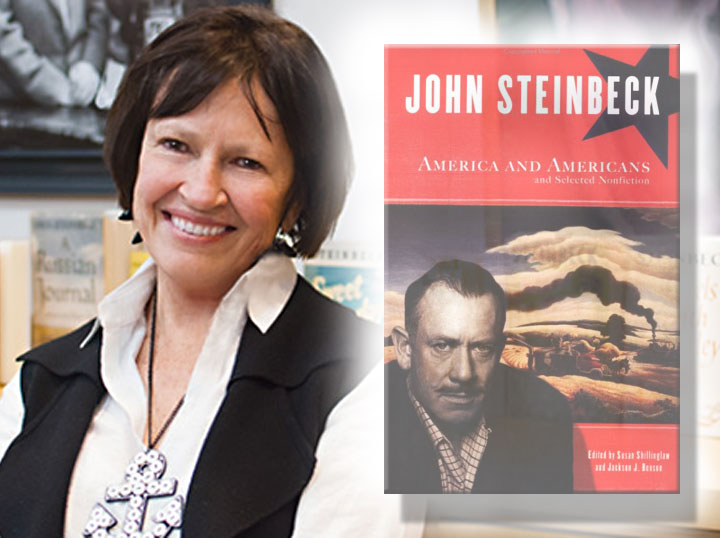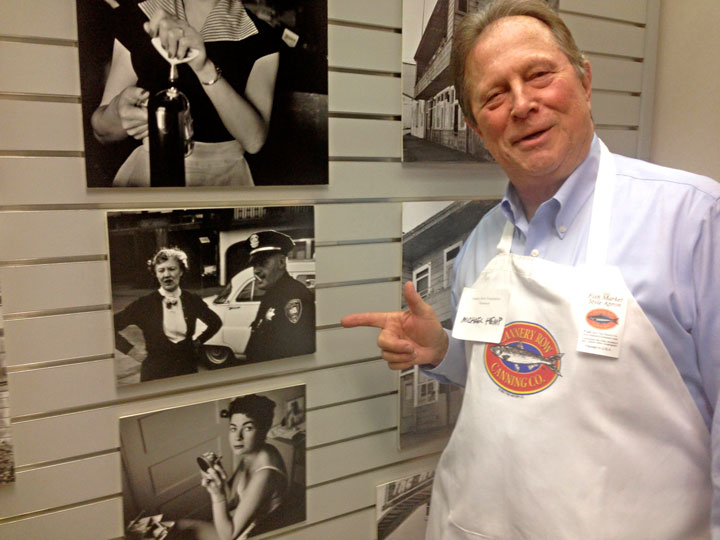Steinbeck lovers from all over convene this Wednesday at San Jose State University’s Martin Luther King, Jr. Library, where Steinbeck experts will probe literary influences, international relations, and various cultural collisions found in the author’s controversial writing and reputation. Speakers for the May 4-6 conference, hosted by the International Society of Steinbeck Scholars, include Robert DeMott and Susan Shillinglaw—former directors of the Martha Heasley Cox Center for Steinbeck Studies at San Jose State and authors of major books on Steinbeck’s life and work—as well Richard Astro, a pioneer in the study of Steinbeck’s friend and collaborator Ed Ricketts; Mimi Gladstein, a Texas theater and English professor who writes about Steinbeck’s depiction of women; and Paul Douglass, an expert on modern literature and philosophy at San Jose State who served as the Steinbeck Center’s director from 2005 to 2013. The conference organizers—led by Nick Taylor, the center’s current director, and Barbara Heavilin, the editor of Steinbeck Review—are prepared for sparks to fly and made plans accordingly. When the conference closes on Friday, attendees will have the option of boarding a bus for Salinas, 90 minutes south of San Jose, where they can decompress by enjoying the 2016 Steinbeck Festival, “Steinbeck on Land and Sea.”
International Relations Explored at John Steinbeck Conference in San Jose
Sea of Cortez at 75: Salinas, California Celebrates John Steinbeck on Land and Sea
The annual Steinbeck Festival held in John Steinbeck’s hometown of Salinas, California is back. In celebration of Steinbeck’s enduring legacy as a writer-activist-ecologist, and the land-and-sea ethic exemplified in his 1941 work Sea of Cortez, the May 6-8, 2016 festival—“Steinbeck on Land and Sea”—features activities designed for a variety of tastes, including informal “JON talks,” documentary films, and tours of the Red Pony Ranch, Ed Ricketts’s lab, and Steinbeck’s Salinas. Whale-watching off the Monterey coast is also part of the mix.
Guest speakers exemplify the festival’s land-and-sea theme from a diversity of backgrounds and perspectives. They include the distinguished Steinbeck scholar Robert DeMott talking about a favorite subject, Steinbeck and fishing; William Souder, the critically acclaimed biographer of Rachel Carson and John James Audubon, introducing his biography-in-progress of John Steinbeck; Katie Rodger, an expert on Ed Ricketts, discussing a newly published essay by Steinbeck’s close friend and collaborator; Kyle Van Houtan, Director of Science at the Monterey Bay Aquarium, on the land-and-sea-and-culture link found in studying sea turtle populations in Hawaii; Gavin Jones, chair of the English department at Stanford University, on Steinbeck, land, drought, and race; and the writer Mary Ellen Hannibal talking about her new book on citizen science and its connections to Steinbeck, Ricketts, and their acquaintance Joseph Campbell.
The multicultural character of this year’s festival line-up matches the population of Salinas, California—and a pattern in John Steinbeck’s life and work, including Sea of Cortez. The author Sergio Chavez, the photographer Daniel Ruanova, and the documentary filmmaker Ignacio Rodriguez will discuss the cultural impact of braceros in the Salinas Valley, Jean Vengua will talk about Fillipino newspapers, and Eric Palmer will show a “teaser” of his new documentary film about Japanese flower growers in the area. John Gregg, owner of the boat Steinbeck and Ricketts sailed to the Sea of Cortez in 1940, will update festival-goers about restoration work on The Western Flyer. Harold Augenbraum, former Director of the National Book Award, will discuss Steinbeck’s frequently-taught novel The Pearl in English and Spanish. Stanford biology professor William Gilly will recount his 2004 trip retracing Steinbeck and Ricketts’s expedition to Baja, and how the Sea of Cortez has changed since Steinbeck and Ricketts made their voyage and wrote their book.
Beer was consumed on The Western Flyer, and Steinbeck once appeared in a magazine ad for Ballantine Ale. This connection to Steinbeck’s life on land and sea will be celebrated in Steinbeck Home Brew Fest, staged in the National Steinbeck Center’s beer garden in collaboration with the Steinbeck Rotary Club, and in “Craft Beer 101,” one of several half-hour “JON talks” planned for this year’s festival. In a related tribute to California’s land-and-sea culture, David Dennis of Ventana Surfboards will show how he makes surfboards from Steinbeck-themed wood.
One-day and three-day tickets can be purchased online at the National Steinbeck Center website or by calling 831-775-4721.
Always Something to Do in Salinas: 2016 John Steinbeck Festival Celebrates Main Street and Sea of Cortez
The National Steinbeck Center will celebrate John Steinbeck’s life, time, and work May 6, 7, and 8 in Salinas, California, the writer’s home town. The 2016 John Steinbeck Festival—“From Salinas to Sea of Cortez: Steinbeck on Land and Sea”—boasts an all-star lineup (the Steinbeck scholar, poet, and fisherman Robert DeMott; Steinbeck’s biographer William Souder; Susan Shillinglaw, the Steinbeck center’s executive director) and a variety of topics, including Steinbeck’s 1940 voyage to the Sea of Cortez, Latino culture and writing in California, and the living heritage of Main Street Salinas. Says Shillinglaw, “There’s ‘always something to do in Salinas,’ as Steinbeck wryly noted in an essay by the same name, and there’s much that is ‘festive’ in the 2016 festival, with Steinbeck Rotary sponsoring Main Street’s first ‘Steinbeck’s Home Brew Fest’ and a beer garden on the NSC patio. In his 1955 essay, Steinbeck noted that the town’s motto was ‘Salinas is,’ adding, ‘I don’t know what that means, but there is no doubt of its compelling tone.’”
Some Walls Are Built as Bridges: San Jose State University Celebrates John Steinbeck and Civil Rights
Some walls separate. Others connect. Admirers at San Jose State University have built a handsome wall to commemorate John Steinbeck’s enduring connection with social justice and civil rights, a tie that is celebrated in the John Steinbeck “In the souls of people” Award, given 15 times since 1996 to artists, actors, writers, and activists whose work involves social change. The award ceremony is always a happy occasion, and the February 24 event honoring civil rights leader Ruby Bridges, the brave little schoolgirl described in Travels with Charley, was no exception.
The John Steinbeck award ceremony is always a happy occasion, and the February 24 event honoring Ruby Bridges, the brave little schoolgirl described in Travels with Charley, was no exception.
The Steinbeck award commemorative wall was created by the San Jose University Student Union and is located in the busy student activity building where most award events are held. Explains Nick Taylor, director of the Martha Heasley Cox Center for Steinbeck Studies at San Jose State University, “The wall consists of a series of disks tracing the timeline of the Steinbeck Award, with background on the rationale for each selection and a few details about each ceremony.” The California civil rights leader Dolores Huerta, an advocate for farm workers’ rights, is a past recipient. Bruce Springsteen received the first award in 1996.
Jim Kent, a member of the John Steinbeck center’s advisory board, traveled to San Jose from Denver for the February 24 event. “As a fan of Travels with Charley,” he said, “I was thrilled to meet the young lady Steinbeck observed as she braved white hecklers during the integration of the New Orleans elementary school where she was the first black student, back in 1960.” A social ecologist who uses Steinbeck in his work empowering citizens to control their own environments, Kent was helping to write federal legislation for Lyndon Johnson’s War on Poverty when the Civil Rights Act of 1965—which owed much to writers like John Steinbeck—passed Congress. “Ruby Bridges was the perfect choice for this year’s award,” he added. “Like Steinbeck, she is a master storyteller. She attracted a capacity crowd made up of all ages and races, and her elegance inspired five standing ovations. There’s clearly a hunger for continued engagement with civil rights in our time. This was proof.”
Ruby Bridges to Receive Steinbeck Award at San Jose State University, February 24
Near the end of Travels with Charley, John Steinbeck celebrates the inspiring courage of Ruby Bridges, the six-year-old schoolgirl who advanced the cause of civil rights by breaking the Southern segregation barrier at a New Orleans elementary school 56 years ago. San Jose State University will honor Bridges’s lasting contribution to civil rights on February 24 by conferring the Steinbeck “In the souls of the people” Award—a program of the school’s Martha Heasley Cox Center for Steinbeck Studies—on the 61-year-old author, activist, and advocate, who has been called the first foot soldier in the modern civil rights movement.
Steinbeck wrote Travels with Charley in sadness, and occasional shock, at the state of America in 1960, when he was 58, and he chose the South as the last stop on his journey of rediscovery and reconciliation because he recognized racism and civil rights as the fundamental conflict to be resolved if the country he loved was to survive. Watching grown white women curse the diminutive black girl entering William Frantz Elementary School in New Orleans turned his stomach, as it did Americans reading newspaper accounts of the widely reported event. Though Ruby Bridges isn’t identified by name, Travels with Charley captures her image, braving the kind of mob Steinbeck depicted better than anyone, like a contemporary news photograph:
The big marshals stood her on the curb and a jangle of jeering shrieks went up from behind the barricades. The little girl did not look at the howling crowd but from the side the whites of her eyes showed like those of a frightened fawn. The men turned her around like a doll, and then the strange procession moved up the broad walk toward the school, and the child was even more a mite because the men were so big. Then the girl made a curious hop, and I think I know what it was. I think in her whole life she had not gone ten steps without skipping, but now in the middle of her first skip the weight bore her down and her little round feet took measured, reluctant steps between the tall guards. Slowly they climbed the steps and entered the school.
Thanks in part to Travels with Charley, Ruby Bridges became an icon of civil rights for succeeding generations—a platform she has used brilliantly as a writer and speaker to advance the values of tolerance, understanding, and equality embraced by Steinbeck in his time. “John Steinbeck expressed concern over an injustice and wrote sympathetically of me when I was a young girl,” she explains. “In a way, we’ve come full circle. I now get to honor him by receiving an award bearing his name. I’m so proud to be part of this.”
Ruby Bridges will speak and accept the Steinbeck Award a public event—“An Evening with Ruby Bridges”—beginning at 7:30 p.m. on February 24 in San Jose State University’s Student Union Theater on the school’s downtown San Jose, California campus. Tickets are available at the Event Center Box Office (408-924-6333) or at Ticketmaster.com.
Timely Topic: John Steinbeck As an International Writer— Planners Invite Proposals for Papers at 2016 Conference in San Jose, California
In a 1946 letter, John Steinbeck described arriving in Denmark to find “thirty cameramen with flashlights . . . . I didn’t know anyone treated writers like this.” He later observed that Denmark was the only country in the world to keep all his books in print. Meanwhile, on the other side of the globe, the John Steinbeck Society of Japan boasts one of the strongest memberships of any foreign author society dedicated to an American author, with annual conferences and a peer-edited scholarly journal. If any 20th-century American author can be considered an “international” writer, it is Steinbeck.
International Society of Steinbeck Scholars Goes Global
The International Society of Steinbeck Scholars is planning to examine Steinbeck as an international writer in a May 4-6, 2016 conference to be held at the Martha Heasley Cox Center for Steinbeck Studies at San Jose State University in San Jose, California. Proposals are being accepted now through February 2016 for papers on a wide variety of theoretical applications, such as Steinbeck’s connections to world literature and world thought—for example, Classical Greek and Roman, Eastern, and twentieth-century Russian. Other topics are welcome as well, such as deep ecology, power and subjugation, the concept of democracy and America, ethics and philosophy, and gender studies.
San Jose State University Event and Salinas/Monterey Steinbeck Festival Scheduled Back to Back: Do Both!
The San Jose, California conference has been scheduled to precede the 2016 Steinbeck Festival in Salinas and Monterey sponsored by the National Steinbeck Center, located less than two hours south by car from San Jose State University’s downtown campus. Many attendees of the 2013 John Steinbeck conference at San Jose State University traveled to Salinas after the conclusion of the academic proceedings to participate in the tours and other activities organized by the National Steinbeck Center, host of the annual weekend-long celebration of one of the most internationally popular American authors of the 20th century.
Love John Steinbeck and Care about International Affairs? Subscribe Today to Steinbeck Review
John Steinbeck ideas and events are international affairs. Need proof? The current issue of Steinbeck Review, a scholarly journal published in the spring and fall for San Jose State University by Penn State Press, demonstrates Steinbeck’s global relevance in an array of articles, book reviews, and announcements of interest to Steinbeck lovers everywhere. Four academic experts—Susan Shillinglaw, Melinda Pham, TK Martin, and Pete Barraza—discuss the topic “Teaching and Living Steinbeck’s Stories” based on decades of classroom experience. Mimi Gladstein, a professor in Texas, focuses on “Immigration Issues: Steinbeck’s Continued Relevance.” Other contributors connect Steinbeck’s writing to issues of ecology, economy, and technology, international affairs of equal importance today. A helpful list of books and papers about John Steinbeck published in 2012-13 further confirms Steinbeck’s continuing appeal, despite declining readership for other authors of his generation. So does a pair of book reviews—one about discovering post-Steinbeck America on the road (with your dog), another about the ongoing controversy over Steinbeck’s alleged involvement with the CIA. The announcement that San Jose State University will host a conference on John Steinbeck’s internationalism in May of 2016, the first such event since 2013, is particularly welcome news for readers of Steinbeck Review outside the United States. Love John Steinbeck’s fiction and follow international affairs? Do yourself a favor. Subscribe today.
John Steinbeck’s Short Story “The Snake”: Context, Sources, and Process
As Steven Federle demonstrates in this paper on “The Snake”—presented at the Cannery Row symposium held four weeks ago at Pacific Grove’s Hopkins Marine Station—Freudian analysis is frequently applied to John Steinbeck’s short story about Ed Ricketts and a disturbing incident at Doc’s Lab. Carl Jung, the Swiss psychologist who fell out with Freud and probed the unconscious using a different theory about dreams, provides another dimension. John Steinbeck was familiar with the dream theories of both men, and his and Ricketts’s friend, the mythologist Joseph Campbell, was deeply influenced by Jung’s version. This illustration from the Red Book—the handwritten record of Jung’s personal dreams and fantasies—suggests why Steinbeck, who liked to draw, was also attracted to Jung, an adept artist with a poet’s soul. As Campbell noted in a later context, Jung’s serpent is a powerful archetype, and Jung’s German inscription can be translated as “Endless Road,” an apt metaphor for John Steinbeck’s fiction. Like Jung, Steinbeck had German roots, supernatural encounters, and an artist’s eye, so Jung’s depth-theory holds as much water as Freud’s when thinking about “The Snake.” After you finish Steven Federle’s helpful account of the sources and writing of “The Snake,” listen to Steinbeck discuss and read the short story and decide for yourself. —Ed.
Writers are not like most people. They observe and record what they see and hear, and then they process that raw material of life through their imaginations, their own bright hopes and dark fears, to create fiction. Writers take the stuff of life as their source and transform it into something completely new.
John Steinbeck was, indeed, a writer, first and foremost, and he transformed the people he knew into characters, the places he knew into settings, and the events he witnessed, through his own struggling creativity, into the plots of the stories we are discussing today. Of course, we are in this beautiful place today because John Steinbeck lived and wrote here. Although Cannery Row is very much different than it was in 1934 (wouldn’t he be amazed?) it does not require much of an imagination to see Steinbeck walking past the Wing Chong Market on his way to the lab . . . and, as I can tell you, walking up the wooden steps into the Pacific Biological Laboratories, it is not hard to imagine Ed and John conversing inside, cold beers in hand.
Clearly, the years 1933 and 1934 were seminal for John Steinbeck. Living with Carol in his father’s cottage in Pacific Grove (desperately poor, both were the classic “starving artists”), he wrote nearly all the stories of The Long Valley, anticipating themes and settings he would later develop into his most important works.
The short story “The Snake” is my subject for today. In this story we see a marine biologist, young Dr. Phillips, modeled on Ed Ricketts. This is the first of many characters who in some way reflect Steinbeck’s good friend.
In this story we see a marine biologist, young Dr. Phillips, modeled on Ed Ricketts. This is the first of many characters who in some way reflect Steinbeck’s good friend.
Many of these short stories were drafted in manuscripts contained in hardbound, ledger notebooks; two are housed in San Jose State University’s Martha Heasley Cox Center for Steinbeck Studies.
The inside cover of the ledger-book containing “The Snake” features some fancy brushwork (John’s or Carol’s?) stating that the ledger book was “marvelously revived” as a manuscript. The facing page features a handwritten table of contents . . . one imagines Steinbeck carefully writing in the title as he finished each draft. Before each story, Steinbeck wrote journal pages, personal notes where he would converse and even argue with himself. In these pages he wrote commentaries on stories recently written, agonized over his struggles with loneliness and self-doubt, and even engaged in small talk. In the notes before “The Snake,” for example, he wondered about the ink he was using. He had been watering it down (no doubt to save money) and wondered if so doing would affect its drying. These were private and never intended for public view. Because of this, the journals provide a valuable window into not only his state of mind but his writing process as well.
The inside cover of the ledger-book containing ‘The Snake’ features some fancy brushwork (John’s or Carol’s?) stating that the ledger book was ‘marvelously revived’ as a manuscript.
John Steinbeck wrote “The Snake” in the summer of 1934, and it was first published in the June 1935, issue of The Monterey Beacon, a small experimental literary magazine run in conjunction with horse stables. In payment for his story, Steinbeck received six month’s use of a steeplechase horse named Cochise. The editor of The Monterey Beacon noted this “horse trade” at the head of the story, and in his letter of July 30, 1935, to Mavis McIntosh, Steinbeck notified his agent of the deal and offered her “ten percent of six month’s riding . . . .” In February of 1938, Esquire published the story under the title “A Snake of One’s Own,” preserving, for the most part, the text of the earlier publication. Later that year, Viking published its most popular version under its original title in The Long Valley.
The plot of “The Snake” remained notably constant throughout its composition and publication, following for the most part Steinbeck’s account of the incident in his memorial essay, “About Ed Ricketts”:
Mysteries were constant at the laboratory. A thing happened one night which I later used as a short story. I wrote it just as it happened. I don’t know what it means and do not even answer the letters asking what its philosophic intent is. It just happened. Very briefly, this is the incident. A woman came in one night wanting to buy a male rattlesnake. It happened that we had one and knew it because it had recently copulated with another snake in the cage. The woman paid for the snake and then insisted that it be fed. She paid for a white rat to be given it. Ed put the rat in the cage. The snake struck and killed it and then unhinged its jaws preparatory to swallowing it. The frightening thing was that the woman, who had watched the process closely, moved her jaws and stretched her mouth just as the snake was doing. After the rat was swallowed, she paid for a year’s supply of rats and said she would come back. But she never did come back. What happened or why I have no idea. Whether the woman was driven by a sexual, a religious, a zoophilic, or a gustatory impulse we never could figure.
The protagonist of “The Snake,” young Dr. Phillips, has “the mild, preoccupied eyes of one who looks through a microscope a great deal.” He returns to his “little commercial laboratory on the cannery street of Monterey” after a day of collecting starfish. While busily engaged in two types of activity—preparing dead specimens (the cat and starfish zygotes) and feeding live ones (including himself)—he is interrupted by a knock on the door. A mysterious, tall woman with black eyes and a “soft, throaty” voice enters and sits motionless while the doctor continues his scientific procedures. Her apparent lack of interest irritates him, and in an effort to shock her into attention, he allows her to watch as he slits a dead cat’s throat and drains its blood. This has no effect on the woman, who calmly asks to purchase a male rattlesnake. She demands that he feed the snake, compelling the now frightened and confused doctor to place a white rat into the snake’s feeding cage. The woman dispassionately watches the kill while the scientist cries, “It’s the most beautiful thing in the world . . . it’s the most terrible thing in the world.” He glances at the entranced woman and sees that she is weaving like the attacking snake, “not much, just a suggestion.” After the snake’s jaws completely engulf the rat, the now relaxed woman leaves the emotionally exhausted doctor to “comb out his thoughts” and try to make sense out of his irrational terror. He is unable to do this, however, for all theories about “psychological sex symbols” do not seem adequate. He never sees the woman again.
The plot of ‘The Snake’ remained notably constant throughout its composition and publication, following for the most part Steinbeck’s account of the incident in his memorial essay, ‘About Ed Ricketts.’
A second account of the source incident can be found in Martha Heasley Cox’s interview with Webster F. Street, who was present in Ricketts’s laboratory that day. According to Street, the strange dark woman was “just a girl that was on the circuit” who “took a fancy to Ed.” Like the lady of Steinbeck’s story, this girl watched in fascination as the snake stalked and devoured the white rat, but unlike the fictional woman, she did not purchase the snake or the rat. Significantly, in Street’s account, it was Ricketts, not the woman, who decided to feed the snake.
In a 1993 recorded interview with Michael Hemp, the writer and philosopher Joseph Campbell described the incident in a decidedly more lighthearted way:
One day [Ricketts] invites us down to see the rattlesnake, puts this little white rat or mouse (I don’t know which it was) and the languid rattlesnake in the other box with the snake in it, the cover on top of it . . . a wire . . . and the little mouse gets in there, and there’s John standing around feeling deep about it, and the little mouse starts sniffing along the length of the rattlesnake and then suddenly seems to have gotten the idea that this isn’t a good place to be, and went over there. The rattlesnake looks over and starts to move, comes over in his direction and then (claps) like that, hits him right here. Two little red spots and the little mouse just spun around and (claps). Then came the next thing. First you’re on the little mouse’s side, you know. Now the mouse is dead so you’re on the rattlesnake’s side. He’s going to eat the thing. The rat was bigger around than the rattlesnake, but Ed said, “now watch him, he’s going to unhook his jaw.” So we watch him unhook his jaw and he comes in and begins taking this thing in and Ed said, “now see, see? He’s being digested right there . . . the saliva can digest him,” and he said, “He’s changing the shape inside there.” The most absurd moment was when all there was left was two legs and a tail sticking out. The rattlesnake got a little tired at that point and just rested a little while and then finally took it all in. This comes out as one of Steinbeck’s stories, “The Snake.”
Although Campbell’s account includes no mention of a woman who wished to see the snake eat a rat, he does corroborate that Ricketts, as in Street’s account, initiated the feeding and explained it to the observers as it proceeded. Perhaps the most significant detail in Campbell’s account, though, is the image of John Steinbeck, “standing around feeling deep about it,” while the others were humorously rooting first for the mouse/rat and then for the snake. There is, however, no sense of horror or mystery in Campbell’s memory of this “absurd” incident.
In a 1987 letter to Michael Hemp, Grove Day, Steinbeck historian and friend, described the incident this way:
[Ed’s] father had caught a rattlesnake on the golf course and put it in a cage. A young lady with us was handling a white mouse and dropped it. Somebody suggested that we feed it to the snake, which had not eaten since captivity. The snake enjoyed its lunch, eating the mouse head-first. Toward the end, the tail made the snake look as if it were smoking a cigarette. John made a Freudian story out of the incident, changing everything around.
Several times in “About Ed Ricketts,” Steinbeck insisted that he wrote the story “just as it happened,” but clearly, as Grove Day said, he changed “everything around.” The story he told in “The Snake” differs significantly in both detail and mood from these eyewitness accounts. The degree to which Steinbeck altered the incident in “The Snake” is, in fact, significant. A careful analysis of the textual variants between the version published in The Long Valley and the handwritten text, located at San Jose State University’s John Steinbeck Center, reveals Steinbeck’s writing process, transforming source materials into the unique product of his individual creativity.
A careful analysis of the textual variants between the version published in ‘The Long Valley’ and the handwritten text, located at San Jose State University’s John Steinbeck Center, reveals Steinbeck’s writing process, transforming source materials into the unique product of his individual creativity.
Steinbeck’s process was one of internalizing and personalizing the events and personalities surrounding him; thus, the incident, described in vastly more matter-of-fact ways by Webster Street, Joseph Campbell, and Grove Day, became something deeply mysterious in Steinbeck’s mind. In his unpublished working notes preceding the handwritten draft of “The Snake,” Steinbeck wrote this:
The story of the snake must be written. I don’t know what it means but it means something very terrible to my unconscious. And I’ll write it slowly out of my unconscious. It’s a terrible story. It’s a damnable story. I don’t know what it means. I don’t know. I’ll write the frightful thing though . . . Carol disapproves of it on the grounds that it is horror for its own sake. I don’t think that is the case at all. And it does have to be written. It would eat me up otherwise.
The most significant substantive variants between the manuscript and the published versions deal with the development of the scientist’s and the woman’s characters, and the psychologically devastating effect on the doctor of their momentary encounter. Changes from the manuscript to the published text serve to emphasize Steinbeck’s intent to show the doctor as a logician who loses his scientific aloofness when confronted with unreasoning, demonic vitality.
In the earlier part of the story, Steinbeck carefully deleted from the final text emotionally charged phrases describing the doctor’s actions. When, for example, the young man was interrupted by a knock on the door, his reaction in both the manuscript and published versions was a “grimace of annoyance,” but in the manuscript the young man “walked to the door and threw it open.” In the published text this act is not so violent; he simply goes “to open” the door. In both the manuscript and The Long Valley, evidence of the doctor’s unemotional, objective manner is abundant. He simultaneously feeds and strokes the cats while calmly gassing one of them in the “killing chamber.” Steinbeck removed all emotional references from the published versions when describing the scientist’s quarters; even the laboratory work light, a “painful white light” in the manuscript, becomes a more neutral “pouring white light” in the published text. With the introduction of the woman, however, the scientist becomes more emotional, a movement clearly seen in Steinbeck’s revisions. In the manuscript Dr. Phillips “felt it was wrong to do the thing, but he didn’t know why.” In the revised text, however, Steinbeck introduced the subjective element of sin and guilt into the doctor’s consciousness: “He felt that it was profoundly wrong to put a rat into the cage, deeply sinful, and he didn’t know why.”
The most significant substantive variants between the manuscript and the published versions deal with the development of the scientist’s and the woman’s characters, and the psychologically devastating effect on the doctor of their momentary encounter.
The dark and irrational presence of the woman causes him to become fearful, and in response to his growing fear, Dr. Phillips attempts to form a rational construct to conceal his terror. The manuscript states: “Lots of people have dreams about the terror of snakes making the kill; I think it’s because it is a subjective rat. The rat is a persona. Once you see this through, the rat is only a rat and you are free from the terror.”
In the revised text, Steinbeck changes the young man’s words to, “Once you see it the whole matter is objective. The rat is only a rat and the terror is removed.” With this revision, Steinbeck is intensifying Dr. Phillips’s attempt to rationalize what is taking place, thereby concealing his irrational core of fear that he will metaphorically become the rat/victim of the metaphorical snake (the woman). Steinbeck emphasizes the doctor’s fall from objectivity into irrational fear through other revisions from the manuscript. In the manuscript, he wrote: “’It’s the most beautiful thing in the world,’ the young man cried. His veins were throbbing.’” In the published text, the added words—“It’s the most terrible thing in the world”—bring an even greater passion to the scientist’s formerly objective perception.
Steinbeck emphasizes the doctor’s fall from objectivity into irrational fear through other revisions from the manuscript. . . . In the published text, the added words—’It’s the most terrible thing in the world’—bring an even greater passion to the scientist’s formerly objective perception.
Unlike Dr. Phillips, the woman remains consistently two-dimensional throughout the story; all revisions from the manuscript to published text serve to strengthen her symbolic force by depersonalizing and flattening her character. The woman seems sensually motivated in Steinbeck’s handwritten draft, but key descriptive words giving her an air of sexual intensity were consistently deleted from the published version. In the manuscript, for example, her eyes “glittered with controlled excitement,” while in the published version her eyes simply “glittered in the strong light.” Later in the manuscript, Steinbeck used the adjective “feverish’ to describe her eyes, a word conspicuously absent from the finished text. While the woman certainly displays a curious identification with the snake, her emotions are never revealed by Steinbeck’s choice of descriptive wording; she remains throughout a faceless mystery. Her presence can be seen to derive from the dynamic interaction of Dr. Phillips’s logical function as a scientist and his emotional, poetic function as a human being. She is perceived as an evil or threatening force as a result of the young man’s refusal to acknowledge that dark, chaotic part of himself. It is interesting that Steinbeck noted this same internal contradiction in his essay “About Ed Ricketts”: “I have said that his mind had no horizons, but that is untrue. He forbade his mind to think of metaphysical or extra-physical matters, and his mind refused to obey him.”
Dr. Phillips’s movement from rational calm to illogical terror is understandable. Far from being a Freudian contest between two distinct individuals, culminating in the young man’s seduction, the process can rather be seen as the psychic rebellion of the doctor’s unconscious. His terror comes from his refusal to accept the unknowable and unexplainable.
Steinbeck’s revision of the story’s end forcefully reveals its mythic basis. In the manuscript, when the doctor tries to comb out his thoughts after the woman has gone, he sarcastically contemplates prayer: “He thought of his life and grinned. ‘Mother Biology, save me from this evil,’ he said. ‘Holy Science! protect me.'”
The satirical tone demonstrates an attempt to dismiss the intrusion of the mythic as a bizarre joke. Steinbeck deleted this passage from his final text because it was inconsistent with the dark tone of the story. In the published work, Dr. Phillips is unable to dismiss the mythic through either logic or ridicule but remains terrified and baffled by the strange encounter.
In the published work, Dr. Phillips is unable to dismiss the mythic through either logic or ridicule but remains terrified and baffled by the strange encounter.
“The Snake” is surely one of Steinbeck’s darkest stories. Several clues as to the source of its dark tone become apparent in the journal entry prior to the start of “The Snake.” One is his fear that he will fail in his goal to become a serious writer:
I work hard enough but nothing happens. When Carol works something happens. I seem to be a bad son, and a bad brother, and a bad husband and a bad citizen all for the sake of being a good writer. If I should turn out to be a bad writer then it’s complete and I have nothing to fall back on. It’s a gamble of not only my own life but the lives of everyone with whom I come in contact. I wish I knew.
Fear of failure is a recurring theme in many of his journal entries; however, before writing “The Snake,” Steinbeck pondered another, deeper, more existential fear. This centers on an undefined event or incident in his life he describes this way:
[Like a] mounting pile of sorrows outside the door. If I open the door, the sorrow would come piling in like a night snowdrift. Oh falling house, crumbling away, rotting. We believe fervently that the event has run its cycle and has come back to nothing, that when the event . . . is gone, that will be done. And we do not want to start it again. We know that by taking this course we will build loneliness in the future against ourselves, but we have seen loneliness among those who should be able to dissipate it and cannot. And the last kind seems so much the worst. We know that when we grow old we shall be grieved by a lasting loneliness, that we will have substituted nothing of any value to ourselves, but at least we will not have provided new instruments to bitterness and to loneliness. Perhaps it is selfishness. But how can one be selfish toward the unborn?
Steinbeck reveals his profound fear of separation and loneliness, both in the present and the future. He refers to a bitter old age when he (and Carol?) will be “grieved by a lasting loneliness,” resulting from “taking this course” that substitutes “nothing of value to ourselves.” What is Steinbeck talking about here? That, of course, is a matter of speculation. His final question, though—“how can one be selfish toward the unborn?”—is compelling. He often spoke of his stories as his children; could he be lamenting stories that would never find life in publication? Or perhaps does he refer to an actual, unborn child? The question is open. In the dark tone of these notes, however, we see the darkness present in “The Snake,” a story he planned to write “slowly out of my unconscious.”
In the dark tone of these notes, we see the darkness present in ‘The Snake,’ a story he planned to write ‘slowly out of my unconscious.’
Clearly, for John Steinbeck, “The Snake” was a “damnable story”; he did not want to write it but felt compelled. In the journal entry written immediately before he began composing “The Snake,” Steinbeck wrestles with personal demons: fear of failure, feelings of inadequacy to make good on his passion to become a successful writer, and, perhaps, a deep sense of loneliness and loss. Characteristically, he uses his writer’s tools, metaphor and imagery, to work through this gloom:
The mind plays. And the gulls are sweeping off the sky. And I wish I knew. Last night the sky was clear and the story was . . . deep, buried in the sky. I was lonelier than I’ve ever been. Sky over ocean is so black. It isn’t when you are out on the ocean. Not nearly so. Then you feel a rhythm with the sky.
Steinbeck identifies his fear with the black sky over the ocean, perhaps representing separation and loneliness, but fear is powerful only if not confronted. When he is on the ocean he again feels connected, and his fear is replaced by a sense of acceptance and oneness with “a rhythm“ of the sky.
This is the road out of the darkness. Just before beginning to write “The Snake,” he describes a “dark silence from the east . . . . A list of [publishers’] rejections.” Unlike Dr. Phillips, John Steinbeck found in his sheer force of will to connect a way to write his way out of the lethargy and fear he felt when he created the disturbing short story that continues to captivate readers, despite the psychological puzzle it still presents. It was a pattern that recurred throughout his troubled career:
. . . the silence is very wearing on the soul. I just have to break this deadlock with a hammer effect. I’ve done that before and I’ll do it again.
It’s His Party; You’re Invited: Celebrate at Doc’s Lab in San Francisco, Carol and John Steinbeck’s Kind of Place
“Lovebattles: Carol and John Steinbeck in the 1930s” is an odd theme for a party, but the author’s 2015 birthday celebration in San Francisco perfectly embodies the bohemian lifestyle of John Steinbeck, his wife Carol Henning, and the colorful circle around Doc’s Lab, Ed Ricketts’s legendary gathering place down the coast on Cannery Row. The new Doc’s Lab—a San Francisco club and restaurant with a storied past of its own—will feature spoken word, food and drink, and songs by Woody Guthrie beginning at 7:00 p.m. on February 28. Dramatic entertainment includes the writer Susan Shillinglaw as Carol Henning, the actor Taelen Thomas as John Steinbeck, and the music of Woody Guthrie (The Ballad of Tom Joad) performed by Steve Mortenson.
Susan Shillinglaw will also read excerpts from Carol and John Steinbeck: Portrait of a Marriage, the popular book she wrote that inspired the idea for the unusual evening. Doc’s Lab’s intimate cellar—former home of the famous Beat-era club, Purple Onion—is party-central for the February 28 event, and City Lights Books, the Beats’ literary home just down the street, is the co-sponsor. Doc’s Lab is located at 124 Columbus Avenue on the western edge of San Francisco’s Jackson Square Historic District. But remember: Carol and John Steinbeck were always casual, even when they argued, so come as you are.
Explore John Steinbeck’s Cannery Row with the Experts on February 21
Monterey California’s historic Cannery Row, the setting of great books by John Steinbeck, is a deep subject. That’s why the not-for-profit Cannery Row Foundation invites you to explore Cannery Row’s past, present, and relevance to John Steinbeck’s life and writing at a February 21 symposium featuring scholars, filmmakers, and artists from the United States and France. The all-day event will take place in the Monterey Boat Works Auditorium of Stanford’s Hopkins Marine Station, where John Steinbeck took college courses and first learned about the unique ecology of the Monterey, California Bay.
Michael Hemp, the energetic author of a popular book about Cannery Row, is the organizer, so expect to be entertained as well as educated. Along with Hemp, speakers include John Steinbeck scholars Richard Astro, Susan Shillinglaw, Steven Federle, and Donald Kohrs; Monterey, California fishing historian Robert Enea; and filmmakers Eva Lothar and Steven and Mary Albert. Historic images showing Monterey, California’s sardine industry from the Pat Hathaway photo collection will be on display, along with paintings and sculpture inspired by John Steinbeck’s great books and Cannery Row characters.
Sign up at symposium@canneryrow.org. The 9:00-5:00 event costs only $25 and space is limited.
